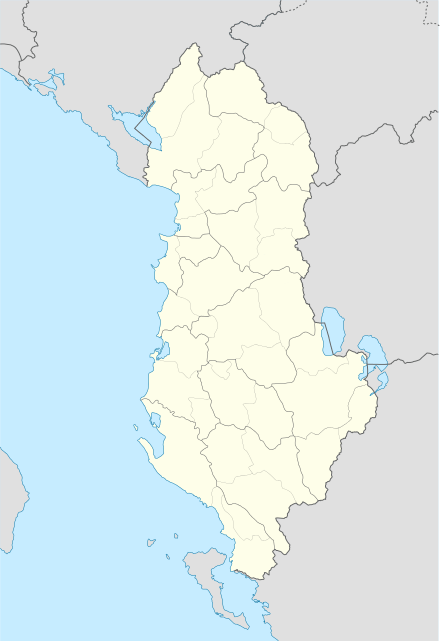Çarçovë
Çarçovë (also: Çarshovë , Greek: Τσαρτσόβα Tsartsova or Κεράσοβο/Kerasovo[1]) is a village, a municipal unit and a former municipality in the Gjirokastër County, southern Albania. At the 2015 local government reform it became a subdivision of the municipality Përmet.[2] The population at the 2011 census was 918.[3] The municipal unit consists of the villages Çarçovë, Vllaho-Psilloterë, Biovizhdë, Zhepë, Draçovë, Iliar-Munushtir, Strëmbec, Pëllumbar and Kanikol.[4] The town of Çarçovë also has Greek and Aromanian communities.[1]
Çarçovë Τσαρτσόβα/Tsartsova | |
|---|---|
 Çarçovë | |
| Coordinates: 40°7′N 20°32′E | |
| Country | |
| County | Gjirokastër |
| Municipality | Përmet |
| Population (2011) | |
| • Total | 918 |
| Time zone | UTC+1 (CET) |
| • Summer (DST) | UTC+2 (CEST) |
Two villages in the former municipality of Çarçovë[5][6] are predominantly Greek speaking, in particular: Biovizhdë and Vllaho-Psilloterë.[7] In Biovizhdë there is a significant Aromanian minority population. Their presence was originally temporary, related to their transhumant lifestyle, before becoming permanent in the village.[8] Some Biovizhdë Aromanians have migrated to Albanian cities.[8] In Vllaho-Psilloterë, three Muslim Albanian families used to live there with a single member from one family still remaining in the early 2010s.[7] Some Greek speakers also exist in the nearby villages of Zhepë and Draçovë.[6] The destroyed village of Mesarë located on the Albanian-Greek border was inhabited by Muslim Albanians.[7]
References
- al.], editors, Vassilis Nitsiakos ... [et (2011). Balkan border crossings : second annual of the Konitsa Summer School. Berlin: Lit. pp. 149–150. ISBN 9783643800923.
"Greeks... as well as in neighbourhoods in Permet and Carshove.... Vlachs also live in mixed neighbourhoods in Permet, Carshove and Leskovik.
CS1 maint: extra text: authors list (link) - Law nr. 115/2014
- 2011 census results
- Greece – Albania Neighbourhood Programme
- Kokolakis, Michalis (2004). Η Τουρκική Στατιστική της Ηπείρου στο Σαλμανέ του 1895 (PDF) (in Greek). Athens, Greece: Institute of Modern Greek Studies. p. 273. Retrieved 2015-07-15.
- Dimitropoulos, Kontsantinos-Fotios (2011). "The Social and Political Structure of Hellenism in Albania in the Post-Hotza Era". www.didaktorika.gr. Panteion University: 11, 13. doi:10.12681/eadd/23044. Retrieved 29 June 2015.
- Nitsiakos, Vassilis (2010). On the border: Transborder mobility, ethnic groups and boundaries along the Albanian-Greek frontier. LIT Verlag. p. 80. "Çarçovë is the base of the homonymous municipality (Komuna Çarçovë), which includes nine more villages, Biovizhdë, Vllaho-Psilloterrë, Zhepe, Kanikol, Dracovë, Pëllumbar, Strembec, Iliar, Manushtir-Toranik, the first two of which are Greek speaking."; p. 254. "He use to tell us about the Muslim beys who used to live in the next settlement, Vllahi, and occupied the land as ciftlik (landed estate), while the Christian inhabitants of the two settlements would work for them as vassals. Our previous interlocutors had referred to these beys, as well as identifying three particular families. One of their descendants still lives in the village, his name is Kurani." pp. 249-263. ; p. 282. "Mesarë (destroyed Muslim Albanian village next to the border)"
- Kahl, Thede (1999). Ethnizität und räumliche Verbreitung der Aromunen in Südosteuropa. Universität Münster: Institut für Geographie der Westfälischen Wilhelms. ISBN 3-9803935-7-7.CS1 maint: ref=harv (link) p. 133. R. Rrămăn (Aromunen mit der Eigenbezeichnung Rrămăn = Farscheroten, Arvanitovlachen)"; p. 144. "Biovizhdë... hoher Anteil R, ursprünglich bodenvage Sommersiedlungen der R, vermutliches Herkunftsgebiet der Farsheroten; heute z.T. gemischte Dauersiedlungen, z.T Abwanderung in sudalbanische Stadte.";

